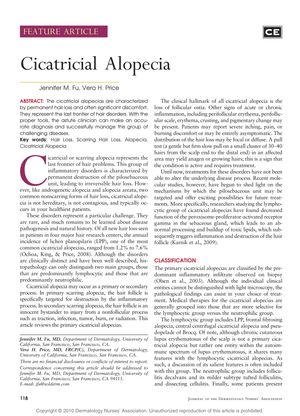TLDR Cicatricial alopecia causes permanent hair loss and is treated to relieve symptoms and stop progression.
Cicatricial alopecia, or scarring alopecia, was a condition characterized by permanent hair loss due to inflammatory destruction of hair follicles, classified into lymphocytic and neutrophilic groups. Diagnosis required a scalp biopsy, and treatment focused on symptom relief and halting progression, as hair regrowth was generally not possible. First-line treatments included hydroxychloroquine and doxycycline, with second-line options like mycophenolate mofetil and cyclosporine if needed. Pioglitazone showed promise in resistant cases, and adjuvant therapies included intralesional triamcinolone acetonide and topical treatments. For neutrophilic types, antimicrobial agents were essential. The condition did not affect general health and was neither hereditary nor contagious.
 66 citations
,
January 2010 in “Journal of The American Academy of Dermatology”
66 citations
,
January 2010 in “Journal of The American Academy of Dermatology” Mycophenolate mofetil was effective for most patients in treating scarring hair loss, but some had side effects.
 105 citations
,
December 2009 in “Archives of dermatology”
105 citations
,
December 2009 in “Archives of dermatology” A specific drug can help treat Lichen Planopilaris, a condition causing permanent hair loss.
46 citations
,
March 2006 in “Seminars in Cutaneous Medicine and Surgery” Current treatments for cicatricial alopecia can manage symptoms but don't stop hair loss or the disease.
226 citations
,
February 1999 in “British Journal of Dermatology” Folliculitis decalvans and tufted folliculitis are related, and a new treatment with rifampicin and clindamycin is effective.
 June 2023 in “Asian Journal of Pharmaceutical Research”
June 2023 in “Asian Journal of Pharmaceutical Research” Different types of hair loss require specific treatments, and new treatments are being developed.
May 2018 in “Journal of cosmetology & trichology” Combining platelet-rich plasma therapy with prostaglandin-F eye drops can significantly regrow hair in alopecia universalis.
 26 citations
,
January 1994 in “McGraw-Hill eBooks”
26 citations
,
January 1994 in “McGraw-Hill eBooks” Many hair loss conditions can be treated.
 1 citations
,
April 1992 in “PubMed”
1 citations
,
April 1992 in “PubMed” The document describes the signs of different common types of hair loss.
 4 citations
,
August 1978 in “PubMed”
4 citations
,
August 1978 in “PubMed” Many women's hair loss is due to health issues, medication, nutrition, or stress.







